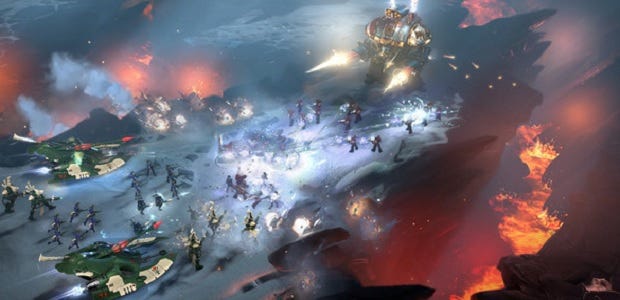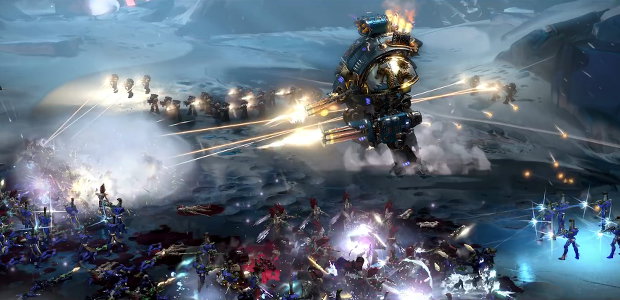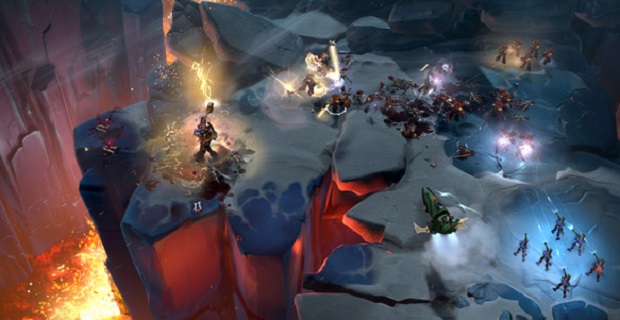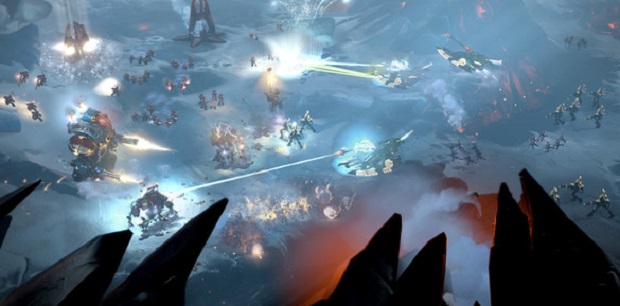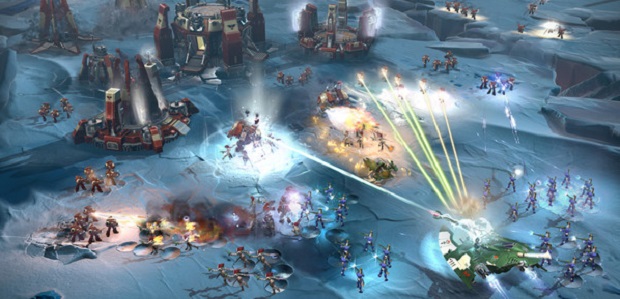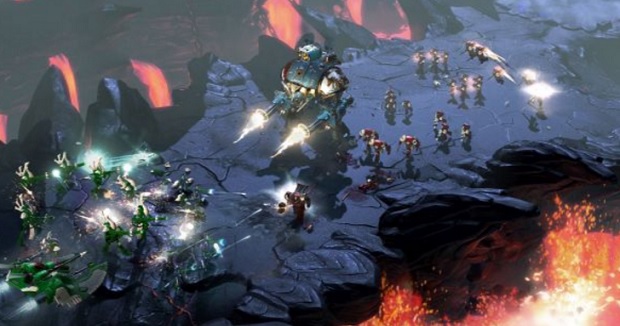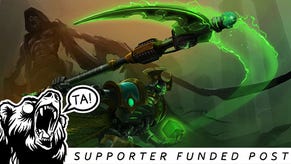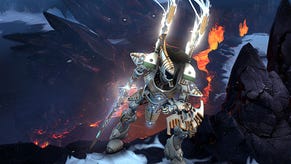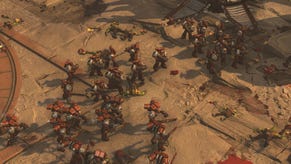Hands On: Dawn Of War III
Tearing the Eldar to pieces with an orbital laser
Last month, I visited Relic at their home in Vancouver. As well as spending a few hours with a single, complete mission from the Dawn of War III [official site] campaign, I had the chance to sit in on short presentations from various members of the team, demonstrating how their own contributions and creativity become part of the bigger picture. There was a lot to absorb, including enough environmental variety to excite the extraterrestrial explorer in me (ruined temples on jungle planets? Yes please), but one series of brief videos stood out, despite containing nothing that hinted at previously unseen planets or units.
The best of the videos used simple shapes to tell me everything I needed to know about the game's races, and how well Relic understand them.
Lead animator Nick Unden showed early test footage that depicted the three lead races – Eldar, Space Marines and Orks – as cuboid gangs, roving across a blank landscape. The Eldar were tall, elongated rectangular blocks of pomposity, rigid and stiff. Marines were bulkier, swivelling as they fell into position, alert and aggressively watching every angle. The Orks were Orks. The spongey green boxes, which swayed from side to side, wobbling and compressing as they bounced along in a ragged formation, couldn't have been anything but Orks.
Relic describe them as “the football hooligans” of the 40k universe, and the chaotic coordination of their rowdy shambling captures that persona perfectly. They're a comic take on hooliganism, amusingly nasty and uncouth rather than idiotically violent and destructive, and the game as a whole recognises the silliness of the setting while also reaching for its grim grandeur. This is the 40k of nobility among carnage, gruesome technology and militant theology, but it's also the 40k that happily shares the same playful and boisterous British blood as 2000AD and even Viz.
All of this is important not only in giving character to the game's three armies, each of which you'll spend time with during a campaign that flits between them, but also in bridging the gap between the original Dawn of War and its sequel. It's not that Dawn of War III takes place between the two games in a narrative sense, but in mechanical terms it spans the more traditional base-building RTS style of Relic's first taste of Warhammer and the more hero-led skirmish-focused setup of Dawn of War II.
The mission that I played, several times, pits the Blood Ravens against an Eldar force. The Eldar are attempting to retrieve a sacred artifact from a planet that is on the brink of some warp-related catastrophe. The Ravens have arrived on a probable suicide mission, hoping to reach the artifact before the Eldar can, no matter what the consequences might be. It's the kind of mission nobody expects to survive, even if they manage to achieve some kind of victory, and it comes quite late in the campaign. I was expecting a challenge and the relief of a group of Relic employees watching over my shoulder mid-way through my first attempt told me that the game had nearly got the better of me.
Here's how that happened.
After an opening in which Blood Ravens Chapter Master Gabriel Angelos fights his way through some puny Eldar forces single-handed, he's joined by Lady Solaria, the proud possessor of a devastating Imperial Knight. These are the two hero units that provide the iron fist and shield of your army, with Angelos the more vulnerable of the two, though still capable of turning the tide in the favour of accompanying marines.
A couple of conversational in-engine cutscenes lead to the arrival of a couple of marine squads, and the delivery of both objectives and the necessary resources to begin construction of a base. That doesn't seem like quite the right word though, 'base', because this is more like a staging area. It is, by nature of the fiction, a temporary facility; there's no intent to fortify the area for more than the hour or two that the planet is likely to survive, and Angelos and Solaria are there to perform a hit and run mission rather than to carry out a successful invasion.
The buildings, which scream down from the skies into position when constructed, are military factories. Whether they're pumping out squads of marines, which come in several distinct flavours, or producing tanks and other vehicles, they're purpose is to provide the hardware necessary for the eternal forward push. The targets of that push, in this mission, are semi-constructed Eldar warpgates. These must be destroyed before the smug space-elves can bring in the bulk of their forces and overwhelm the scrappy Space Marines, who are effectively stranded and out of their depth.
Of course, those buildings aren't materialising in the void. There's a fleet overhead and they're capable of sending down reinforcements as well as buildings. Drop pods take a while to prepare and when a unit is loaded into place, a timer (in the form of a bar rather than a numerical display) counts down. A precise or fortunate spot of timing can save your skin should you over-commit and risk losing an army. As in Dawns of War past, drop pods not only provide immediate reinforcements, they also squash any enemies foolish enough to exist at the point where they land. In true Space Marine fashion, they're weapons as well as transports.
Fairly tight unit limits and the delays associated with both drop pods and in-facility production prevent Dawn of War III from becoming a game of 'who clicks fastest triumphs'. An ability to switch between use of individual active skills during combat and control of reinforcements half-way across the map is certainly useful, but the mission I played rewarded planning rather than perspiration.
There are several paths to take, each presenting certain obstacles, from geographic features that create killzones to areas of cover heavily populated with Eldar. Each route has its own challenges on both a tactical and a strategic level. The gates produce Eldar from time to time, an event signalled by a warning allowing you to prepare, and if you're not willing to leave troops behind for defensive duties it's best to position your attacking force intelligently, cutting off potential Eldar routes and taking the fight to them before they can reach your base.
If you lose the base, you lose the mission, you see. It's easy enough to defend, if you commit even a few units to the task, perhaps even disappointingly so. The Eldar attack in small waves and while it's possible that they'll increase their force over time, or that a higher difficulty level would have made them more of a threat right from the outset, I never ran into a marauding group that I couldn't overcome. Hero units cut through them with ease, and once I'd filled my third slot with a Terminator Assault squad, little could stand in my way.
Except, as mentioned earlier, I almost failed the mission.
My mistake was to recognise that I was on the front foot, always pushing toward my final objective, and then assuming that my back foot was secure. A puny Eldar party attacked my base and even though it took them a matter of minutes to burn through the buildings, they were on the verge of destroying my headquarters when I noticed how much damage they'd done and realised I needed to drop some pods on their heads right away. Even the slightest leak can cause a flood if nobody seals it.
There's plenty of feedback to let you know when your attention is needed, beginning with a very efficient minimap. The only excuse I can offer for my dereliction of duty is that I was enjoying the tactical combat in the thick of the action so much that I didn't give a crap about anything as lifeless as a base.
When it comes to the actual business of fighting, Dawn of War III finds the sweetest of spots. Every unit is useful, if deployed correctly, and even when the chainswords rumble into action and the heavy bolters send death thudding across the battlefield, there's enough maneuverability to allow for tactical changes. If a unit is pinned down, you can at least try to move them to cover, or to cause a distraction. Assault squads can use their jump packs to boost into flanking positions, or to disrupt poorly armoured ranged units. Tanks roll ahead while artillery avoid the thick of the fight, picking off the most powerful enemy units.
And through it all the heroes rip and tear their way toward victory.
They come in various forms, with the three on show in the preview mission presenting a fairly good spread. Solaria is practically unkillable (they're all technically unkillable, respawning once a very long cool-down has run its course) but her special abilities require some attention if they're going to be effective. A missile barrage allows the player to select several targets and is best used either to soften up a tough cookie so that it'll crumble more easily, or to wipe out an entire defensive front. Her minigun attack - which sees the Imperial Knight adopt the most ludicrously wonderful badass stance as it preps both enormous weapons like a cowboy cocking his revolvers – is much more effective against scattered infantry than against vehicles.
Angelos is trickier. He's strong, for what is essentially a man, but he'll end up down and out if you don't provide some protection when he goes up against overwhelming odds. As befits his character, he's best used at the head of a couple of Marine squads, leading them and providing support rather than trying to take down the Eldar single-handed. The Assault Terminators, the final available super unit in the build I played, are like ultra-powerful Marine Assault squads, capable of teleporting from place to place, carving up their enemies as they go.
There's a clever balancing act. The tougher units often require the most attention to get the best out of them, and that filters down to every part of an army. During the final assault, which pits your army against a terrifying, gigantic Wraithknight, every piece of the military machine has to pull its full weight. Without direction, even the biggest block of tanks are likely to fail because the Eldar monstrosity will simply scurry out of range and deal death from afar.
That final fight is the realisation of both the army construction that base-building allows and the close tactical attention that the active skills and hero units demand. If it can be replicated through the rest of the campaign, Dawn of War III will be a triumph.
When an orbital laser is raining down destruction, guided by your cursor, and Eldar are evaporating within the beam, this really does feel like the most 40k game ever made. It's loud, busy and packed with detail, but even as I was playing, I kept thinking back to those colourful cubes marching across the screen.
At its heart, Dawn of War III is that game of cubes screamed through a megaphone. No matter how noisy the battlefield gets, you can quickly read the situation. Those Eldar are burning through your vehicles armour quickly, right? The big, fiery laserbeams that are scorching your tanks are a dead giveaway. And aren't those the marines that can jump behind the big, fiery laserbeam Eldar and stab them in the back? Yep. The throbbing great jetpacks hanging from their shoulders probably tipped you off.
It's a game of broad, extravagant gestures, scaling down from that orbital death laser to the idle animations of every individual unit. And as an RTS game, it has the balance between strategic awareness and tactical detail superbly balanced, in this one mission at the very least. While not giving direct control of the units, the special abilities give you the sense of what it would be like to pilot an Imperial Knight. It would be amazing. There's an almost alarming weight to the physics of the largest machines but even tanks trundle and roll convincingly. Strip away the fancy visuals though and I'd definitely take a minimalist, cuboid version of the game for a spin. Thomas Was In a Grimdark Future-War.
Dawn of War III will be out next year.
